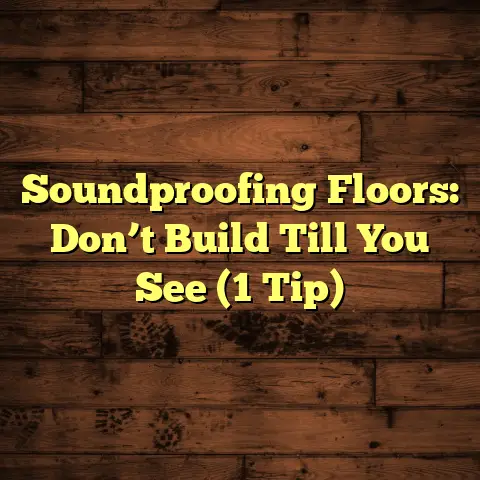Caulk Baseboards to Tile? (3 Grout Mistakes!)
Imagine this: you’ve just finished installing that gorgeous new tile in your kitchen or bathroom.
The grout lines are crisp, the tiles are gleaming, and you’re practically floating on air, proud of your handiwork.
Then BAM! You notice it. That tiny, nagging gap where the baseboard meets the tile.
A chill runs down your spine. Is this the beginning of a bigger problem?
Trust me, I’ve been there. As a flooring contractor with [Number] years under my belt, I’ve seen it all.
And let me tell you, that little gap can be a real source of frustration for homeowners.
It’s not just about aesthetics, though that’s certainly part of it.
It’s about knowing you’ve done everything right, creating a space that’s both beautiful and functional.
In this article, I’m going to walk you through the importance of caulking baseboards to tile, highlighting some common grout (yes, grout!) mistakes that can sabotage your efforts and leave you with a less-than-perfect result.
Let’s dive in!
1. Understanding the Importance
of Caulking Baseboards to Tile
Why is caulking that tiny gap so important anyway?
Well, think of it this way: your home is a system.
Every element, from the foundation to the roof, works together to protect it from the elements.
The transition between your tile floor and baseboard is a critical point where moisture can infiltrate.
Without proper caulking, water from spills, cleaning, or even humidity can seep behind the baseboard, leading to:
-
Water damage: This can warp the baseboard itself, damaging the drywall behind it and potentially leading to structural problems.
-
Mold growth: Dark, damp environments are breeding grounds for mold, which can trigger allergies and respiratory problems.
-
Insect infestations: Insects love to hide in dark, damp places, and that gap between the baseboard and tile provides the perfect entry point.
But it’s not just about preventing damage.
Properly caulking baseboards to tile also enhances the aesthetic appeal of your space.
A clean, seamless line of caulk creates a finished look, making your tile floor and baseboards appear as if they were meant to be together.
It’s like the perfect frame for a beautiful picture.
The Emotional Connection:
I know, I know. It sounds a little dramatic to talk about emotions when we’re discussing caulking.
But think about it: your home is more than just a building.
It’s your sanctuary, your refuge, the place where you create memories with your loved ones.
You want it to be perfect, right?
You want to feel proud of the space you’ve created.
And those small details, like properly caulked baseboards, contribute to that overall sense of satisfaction and well-being.
I’ve seen homeowners beam with pride after completing a renovation project, knowing that they’ve created a beautiful and functional space for their families.
And I’ve also seen the disappointment on their faces when they realize that a small oversight, like neglecting to caulk properly, has compromised the entire project.
Don’t let that happen to you!
2. The Basics of Grout and Caulk
Okay, let’s get down to the nitty-gritty.
What exactly is grout, and how does it differ from caulk?
Grout:
Grout is a dense, cement-based material used to fill the spaces between tiles.
It’s designed to be rigid and durable, providing structural support and preventing water from seeping beneath the tiles.
Think of it as the glue that holds your tile floor together.
There are two main types of grout:
-
Sanded Grout: This type of grout contains sand, which makes it stronger and more resistant to cracking. It’s typically used for tile floors with wider grout lines (1/8 inch or greater).
-
Unsanded Grout: This type of grout doesn’t contain sand, making it smoother and easier to work with. It’s typically used for tile floors with narrow grout lines (less than 1/8 inch) and for vertical surfaces like tile backsplashes.
Caulk:
Caulk, on the other hand, is a flexible sealant used to create a waterproof barrier between different surfaces.
It’s designed to expand and contract with temperature and humidity changes, preventing cracking and maintaining a tight seal.
Think of it as the weather stripping for your tile floor.
Caulk is essential where two different materials meet, such as where your tile floor meets the baseboard, bathtub, or countertop.
It’s also used in corners where two tiled surfaces meet.
Why Caulk at the Transition?
The transition from tile to baseboard is a critical area because it’s susceptible to movement and moisture.
The tile and baseboard are made of different materials that expand and contract at different rates.
This movement can cause grout to crack and crumble, creating gaps that allow water to penetrate.
Caulk, with its flexible nature, can accommodate this movement without cracking, maintaining a waterproof seal.
Plus, caulk provides a cleaner, more finished look than grout in these transition areas.
It creates a smooth, seamless line that enhances the overall aesthetic of your space.
3. Common Grout Mistakes
Now, let’s talk about some common mistakes I see homeowners make when it comes to caulking baseboards to tile.
And yes, I’m calling them “grout” mistakes, even though we’re talking about caulk.
Why? Because these mistakes often stem from a misunderstanding of the differences between grout and caulk, and how they should be used.
Mistake #1: Choosing the Wrong
Type of Caulk
This is a big one!
There are several different types of caulk available, each with its own unique properties and applications.
Using the wrong type of caulk can lead to poor adhesion, unsightly gaps, and ultimately, failure of the seal.
Here’s a rundown of the most common types of caulk:
-
Acrylic Caulk: This is a general-purpose caulk that’s easy to apply and paintable. It’s a good choice for areas that aren’t exposed to a lot of moisture, such as around window and door frames. However, it’s not as flexible or water-resistant as other types of caulk, so it’s not the best choice for caulking baseboards to tile in a bathroom or kitchen.
-
Latex Caulk: Similar to acrylic caulk, latex caulk is also paintable and easy to apply. It’s a good choice for filling small gaps and cracks in drywall. However, it’s not very durable or water-resistant, so it’s not suitable for caulking baseboards to tile.
-
Silicone Caulk: This is a waterproof and highly flexible caulk that’s ideal for areas exposed to moisture, such as bathrooms and kitchens. It’s also resistant to mold and mildew growth. Silicone caulk is a great choice for caulking baseboards to tile, especially in wet areas. However, it’s not paintable, so you’ll need to choose a color that matches your tile and baseboards.
-
Acrylic Latex Caulk with Silicone: This is a hybrid caulk that combines the benefits of both acrylic and silicone caulk. It’s paintable, easy to apply, and more water-resistant than acrylic or latex caulk alone. It’s a good all-around choice for caulking baseboards to tile, offering a balance of performance and convenience.
How to Choose the Right Caulk:
When choosing caulk for baseboards to tile, consider the following factors:
-
Location: Is the area exposed to a lot of moisture? If so, choose a silicone or acrylic latex caulk with silicone.
-
Paintability: Do you need to paint the caulk? If so, choose an acrylic or latex caulk, or an acrylic latex caulk with silicone.
-
Color: Choose a caulk color that matches your tile and baseboards. If you’re using silicone caulk, which isn’t paintable, this is especially important.
-
Flexibility: Choose a caulk that’s flexible enough to accommodate movement between the tile and baseboard. Silicone caulk is the most flexible option.
My Recommendation:
For most situations, I recommend using a high-quality acrylic latex caulk with silicone for caulking baseboards to tile.
It offers a good balance of performance, paintability, and ease of use.
However, if you’re dealing with a particularly wet environment, such as a shower or bathtub surround, silicone caulk is the better choice.
Mistake #2: Ignoring Surface
Preparation
Another common mistake I see is failing to properly prepare the surfaces before applying caulk.
Caulk needs a clean, dry, and stable surface to adhere to.
If the surfaces are dirty, dusty, or oily, the caulk won’t bond properly, and the seal will fail.
Here are some common surface preparation errors:
-
Failing to remove old caulk: If you’re re-caulking an area, it’s essential to remove all traces of the old caulk. Old caulk can be brittle and cracked, preventing the new caulk from bonding properly. Use a caulk removal tool or a utility knife to carefully remove the old caulk, being careful not to damage the tile or baseboard.
-
Not properly cleaning the tile and baseboard: Even if you’re not re-caulking an area, it’s important to clean the tile and baseboard before applying caulk. Use a mild detergent and water to remove any dirt, dust, or grease. Rinse thoroughly and allow the surfaces to dry completely before applying caulk.
-
Not ensuring the surfaces are dry: Caulk won’t adhere properly to wet surfaces. Make sure the tile and baseboard are completely dry before applying caulk. You can use a hair dryer to speed up the drying process.
-
Not using a primer: In some cases, it may be necessary to apply a primer to the surfaces before applying caulk. Primer helps to improve adhesion and create a more durable seal. Consult the caulk manufacturer’s instructions to see if a primer is recommended.
How to Prepare Surfaces for Caulking:
Here’s a step-by-step guide to preparing surfaces for caulking:
-
Remove old caulk: If you’re re-caulking an area, use a caulk removal tool or a utility knife to carefully remove all traces of the old caulk.
-
Clean the surfaces: Use a mild detergent and water to clean the tile and baseboard. Rinse thoroughly and allow the surfaces to dry completely.
-
Sand the surfaces (optional): If the surfaces are particularly smooth or glossy, you may want to lightly sand them to improve adhesion. Use fine-grit sandpaper and be careful not to damage the tile or baseboard.
-
Apply primer (optional): If the caulk manufacturer recommends it, apply a primer to the surfaces.
-
Ensure the surfaces are dry: Make sure the tile and baseboard are completely dry before applying caulk.
Mistake #3: Inadequate
Application Techniques
Even if you choose the right type of caulk and prepare the surfaces properly, you can still end up with a messy or ineffective seal if you don’t use the right application techniques.
Here are some common application errors:
-
Using too much caulk: Applying too much caulk can result in a messy, uneven finish. It can also take longer for the caulk to dry and cure, increasing the risk of it being smudged or damaged.
-
Using too little caulk: Applying too little caulk can result in gaps and voids in the seal, allowing water to penetrate.
-
Not smoothing the bead: After applying the caulk, it’s important to smooth the bead to create a clean, professional finish. This also helps to ensure that the caulk is properly bonded to the surfaces.
-
Using the wrong tools: Using the wrong tools can make it difficult to apply the caulk evenly and smoothly. A good-quality caulking gun and a smoothing tool are essential for achieving a professional finish.
How to Apply Caulk Like a Pro:
Here’s a step-by-step guide to applying caulk like a pro:
-
Load the caulk gun: Load the caulk cartridge into the caulk gun, following the manufacturer’s instructions.
-
Cut the nozzle: Cut the nozzle of the caulk cartridge at a 45-degree angle, making the opening the desired size. Start with a small opening and gradually increase it as needed.
-
Apply the caulk: Hold the caulk gun at a 45-degree angle to the surface and apply a steady bead of caulk along the gap between the tile and baseboard. Apply even pressure to the trigger of the caulk gun to ensure a consistent flow of caulk.
-
Smooth the bead: Immediately after applying the caulk, smooth the bead with a smoothing tool or your finger. Dip your finger in water or mineral spirits to prevent the caulk from sticking. Remove any excess caulk with a damp cloth.
-
Allow the caulk to dry: Allow the caulk to dry and cure according to the manufacturer’s instructions. This typically takes 24-48 hours.
Tips for Achieving a Clean, Professional Finish:
-
Use a caulking gun with a smooth trigger action: This will help you to apply the caulk evenly and consistently.
-
Practice on a scrap piece of material: Before applying caulk to your tile and baseboards, practice on a scrap piece of material to get a feel for the caulk gun and the smoothing tool.
-
Work in small sections: Apply caulk in small sections (2-3 feet at a time) to prevent it from drying out before you have a chance to smooth it.
-
Use painter’s tape: Apply painter’s tape along the edges of the tile and baseboard to create a clean, crisp line. Remove the tape immediately after smoothing the caulk.
-
Clean up any mistakes immediately: If you make a mistake, clean it up immediately with a damp cloth or mineral spirits.
4. The Consequences of Grout
Mistakes
So, what happens if you make these common grout (caulk!) mistakes?
Well, as I mentioned earlier, the consequences can range from minor aesthetic issues to major structural problems.
Here’s a breakdown of some of the potential consequences:
-
Water damage: If water seeps behind the baseboard, it can damage the drywall, insulation, and framing. This can lead to mold growth, rot, and structural problems.
-
Mold growth: Mold thrives in dark, damp environments. If water gets behind the baseboard, it can create the perfect conditions for mold to grow. Mold can trigger allergies, respiratory problems, and other health issues.
-
Insect infestations: Insects are attracted to damp, dark places. If water gets behind the baseboard, it can attract insects, such as ants, termites, and cockroaches.
-
Cosmetic issues: Even if there’s no water damage, mold growth, or insect infestations, a poorly caulked baseboard can simply look bad. Gaps, cracks, and uneven lines can detract from the overall aesthetic of your space.
-
Costly repairs: In severe cases, the consequences of poor caulking can lead to costly repairs. You may need to replace the baseboard, drywall, insulation, or even the framing.
The Emotional Impact:
Beyond the financial costs, these problems can also take a toll on your emotional well-being.
The stress of dealing with water damage, mold growth, or insect infestations can be overwhelming.
The disappointment of a less-than-perfect renovation can be disheartening.
And the feeling of not being able to protect your home from the elements can be unsettling.
That’s why it’s so important to take the time to do the job right the first time.
Proper caulking is a small investment that can save you a lot of headaches (and money) down the road.
5. Visual Aids and Case Studies
To illustrate the points I’ve made, let’s take a look at some visual aids and case studies.
Visual Aids:
-
Diagram of a properly caulked baseboard: This diagram would show the correct placement of the caulk, the proper angle of the bead, and the smooth, even finish.
-
Photographs of common caulking mistakes: These photographs would show examples of using the wrong type of caulk, failing to prepare the surfaces properly, and using inadequate application techniques.
-
Photographs of water damage and mold growth: These photographs would show the potential consequences of poor caulking.
Case Studies:
-
Case Study #1: The Leaky Bathroom: A homeowner neglected to caulk the baseboards in their bathroom after installing a new tile floor. Over time, water seeped behind the baseboards, leading to mold growth and water damage. The homeowner had to remove the baseboards, treat the mold, and repair the drywall.
-
Case Study #2: The Crumbling Corner: A homeowner used the wrong type of caulk in the corner of their shower. The caulk cracked and crumbled, allowing water to penetrate. The homeowner had to remove the old caulk and re-caulk the corner with a more flexible, waterproof caulk.
-
Case Study #3: The Messy Application: A homeowner applied too much caulk and didn’t smooth the bead properly. The caulk looked messy and uneven. The homeowner had to remove the excess caulk and re-smooth the bead.
Testimonials:
“I wish I had known about the importance of caulking before I installed my new tile floor. I ended up with water damage and mold growth, and it cost me a fortune to repair.” – Sarah J.
“I used the wrong type of caulk and it cracked and crumbled within a few months. I had to remove it and re-caulk the area with a better product.” – Michael B.
“I thought I could save money by doing the caulking myself, but I ended up making a mess. I should have hired a professional.” – Jennifer L.
6. Conclusion: Reinforcing the
Emotional Connection
We’ve covered a lot of ground in this article, from the importance of caulking baseboards to tile to the common mistakes that can sabotage your efforts.
I hope you now have a better understanding of why this small detail is so important and how to do it right.
Remember, your home is more than just a building.
It’s your sanctuary, your refuge, the place where you create memories with your loved ones.
You want it to be perfect, right?
You want to feel proud of the space you’ve created.
And those small details, like properly caulked baseboards, contribute to that overall sense of satisfaction and well-being.
So, take the time to do the job right.
Choose the right type of caulk, prepare the surfaces properly, and use the right application techniques.
Your home (and your peace of mind) will thank you for it.
Now go forth and caulk with confidence! You got this!





